Bulbuls are a family, Pycnonotidae, of medium-sized passerine songbirds. Many forest species are known as greenbuls, brownbuls, leafloves, or bristlebills. The family is distributed across most of Africa and into the Middle East and Asia. There are about 130 species in around 24 genera.
Bulbuls are short-necked slender passerines. The tails are long and the wings short and rounded. In almost all species the bill is slightly elongated and slightly hooked at the end. Overall the sexes are alike, although the females tend to be slightly smaller. The soft plumage of some species is colourful with yellow, red or orange vents, cheeks, throat or supercilia, but most are drab, with uniform olive brown to black plumage. Species with dull coloured eyes often sport contrasting eyerings. Some have very distinct crests. Bulbuls are highly vocal, with the calls of most species being described as nasal or gravelly.
Bulbuls eat a wide range of different foods, ranging from fruit to seeds, nectar, small insects and other arthropods and even small vertebrates. The majority of species are frugivorous and supplement their diet with some insects, whilst there is a significant minority of specialists, particularly in Africa. Open country species in particular are generalists.
The bulbuls are generally monogamous. Up to five purple-pink eggs are laid in an open tree nests and incubated by the female. Incubation usually lasts between 11–14 days, and chicks fledge after 12–16 days.
Africa Wild Bird Book
Family Pycnonotidae (Bulbuls) Index
Family Pycnonotidae (Bulbuls)
Pycnonotus nigricans African Red-eyed Bulbul 567
Pycnonotus capensis Cape Bulbul 566
Pycnonotus tricolor Dark-capped Bulbul 568
Arizelocichla fusciceps Black-browed Greenbul
Arizelocichla milanjensis Stripe-cheeked Greenbul 573
Andropadus importunus Sombre Greenbul 572
Chlorocichla flaviventris Yellow-bellied Greenbul 574
Phyllastrephus terrestris Terrestrial Brownbul 569
Phyllastrephus cerviniventris Grey-olive Greenbul
Phyllastrephus flavostriatus Yellow-streaked Greenbul 570
Phyllastrephus debilis Lowland Tiny Greenbul 571
Pycnonotus nigricans African Red-eyed Bulbul 567
Pycnonotus capensis Cape Bulbul 566
Pycnonotus tricolor Dark-capped Bulbul 568
Arizelocichla fusciceps Black-browed Greenbul
Arizelocichla milanjensis Stripe-cheeked Greenbul 573
Andropadus importunus Sombre Greenbul 572
Chlorocichla flaviventris Yellow-bellied Greenbul 574
Phyllastrephus terrestris Terrestrial Brownbul 569
Phyllastrephus cerviniventris Grey-olive Greenbul
Phyllastrephus flavostriatus Yellow-streaked Greenbul 570
Phyllastrephus debilis Lowland Tiny Greenbul 571
African Red-eyed Bulbul
567. African Red-eyed Bulbul Pycnonotus nigricans (Rooioogtiptol)
Order: Passeriformes. Family: Pycnonotidae
Description
Length 19-22 cm, weight 31 g. Dark, slightly crested black head, black bill, red eye-ring. Brown back and tail, lemon-yellow vent, light brown breast shading downwards to white belly. Sexes are alike.
The juvenile's eye-ring is initially narrower and pale pink.
Similar species: The bright orange-red eye-ring distinguishes this species from Dark-capped Bulbul and Cape Bulbul. The head colour is darker than that of the Dark-capped Bulbul and contrasts with the greyish buff collar and upper breast.
Distribution
The African red-eyed Bulbul is near endemic to southern Africa, marginally extending into southern Angola and Zambia. In southern Africa it is common across Namibia (with the exception of the Namib Desert), Botswana, and central South Africa, centered around the Free State, North-West Province and inland Eastern Cape, also extending in to other provinces.
P. n. nigricans: sw Angola, Namibia and Botswana and w South Africa
P. n. superior: c South Africa
Habitat
Wide variety of arid and semi-arid habitats, such Acacia savanna, semi-arid shrublands, riverine bush and gardens in arid areas. Never far from water and has benefited from provisioning of waterpoints for livestock.
Diet
Feeds on fruit, insects, pollen and nectar. It forages mostly in trees, seldom on the ground and they often hawk insects in flight.
Breeding
Monogamous and territorial. The nest is typically built by the female, and is a untidy cup of fine twigs, dry grass and other small plant fibres, reinforced with spider web. It is usually concealed in the fork of a bush or tree branch, occasionally on a grape vine support frame. Egg-laying season is from September-April, peaking around October-December. It lays 2-3 eggs which are incubated solely by the female for about 11-13 days. The chicks are fed by both parents, leaving the nest after about 12 days, and can fly competently roughly a week later.
They are regularly parasitised by the Jacobin cuckoo.
Call
The male often calls from the top of a bush or tree – till-pop-peep-peep-tiddlypop or similar. Listen to Bird Call.
Status
Very common, near endemic resident. Mostly resident with some regional local movements. Usually in pairs or small family parties.
Order: Passeriformes. Family: Pycnonotidae
Description
Length 19-22 cm, weight 31 g. Dark, slightly crested black head, black bill, red eye-ring. Brown back and tail, lemon-yellow vent, light brown breast shading downwards to white belly. Sexes are alike.
The juvenile's eye-ring is initially narrower and pale pink.
Similar species: The bright orange-red eye-ring distinguishes this species from Dark-capped Bulbul and Cape Bulbul. The head colour is darker than that of the Dark-capped Bulbul and contrasts with the greyish buff collar and upper breast.
Distribution
The African red-eyed Bulbul is near endemic to southern Africa, marginally extending into southern Angola and Zambia. In southern Africa it is common across Namibia (with the exception of the Namib Desert), Botswana, and central South Africa, centered around the Free State, North-West Province and inland Eastern Cape, also extending in to other provinces.
P. n. nigricans: sw Angola, Namibia and Botswana and w South Africa
P. n. superior: c South Africa
Habitat
Wide variety of arid and semi-arid habitats, such Acacia savanna, semi-arid shrublands, riverine bush and gardens in arid areas. Never far from water and has benefited from provisioning of waterpoints for livestock.
Diet
Feeds on fruit, insects, pollen and nectar. It forages mostly in trees, seldom on the ground and they often hawk insects in flight.
Breeding
Monogamous and territorial. The nest is typically built by the female, and is a untidy cup of fine twigs, dry grass and other small plant fibres, reinforced with spider web. It is usually concealed in the fork of a bush or tree branch, occasionally on a grape vine support frame. Egg-laying season is from September-April, peaking around October-December. It lays 2-3 eggs which are incubated solely by the female for about 11-13 days. The chicks are fed by both parents, leaving the nest after about 12 days, and can fly competently roughly a week later.
They are regularly parasitised by the Jacobin cuckoo.
Call
The male often calls from the top of a bush or tree – till-pop-peep-peep-tiddlypop or similar. Listen to Bird Call.
Status
Very common, near endemic resident. Mostly resident with some regional local movements. Usually in pairs or small family parties.
African Red-eyed Bulbul Photos
567. African Red-eyed Bulbul Pycnonotus nigricans
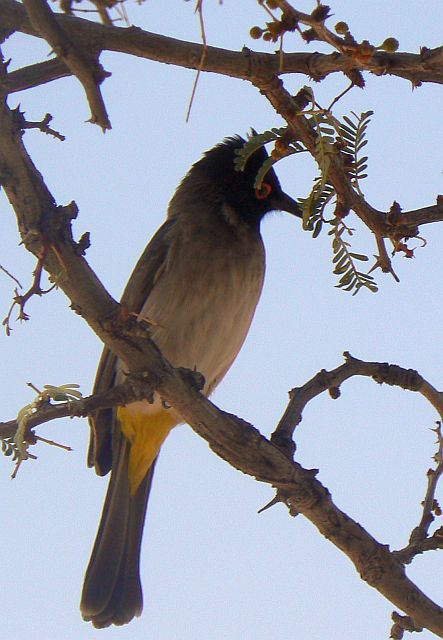 © Toko
© Toko
Kgalagadi Transfrontier Park
 © Toko
© Toko
Marakele National Park
 © Mel
© Mel
Links:
Species text Sabap1
Sabap2
 © Toko
© TokoKgalagadi Transfrontier Park
 © Toko
© TokoMarakele National Park
 © Mel
© MelLinks:
Species text Sabap1
Sabap2
Cape Bulbul
566. Cape Bulbul Pycnonotus capensis (Kaapse Tiptol)
Order: Passeriformes. Family: Pycnonotidae
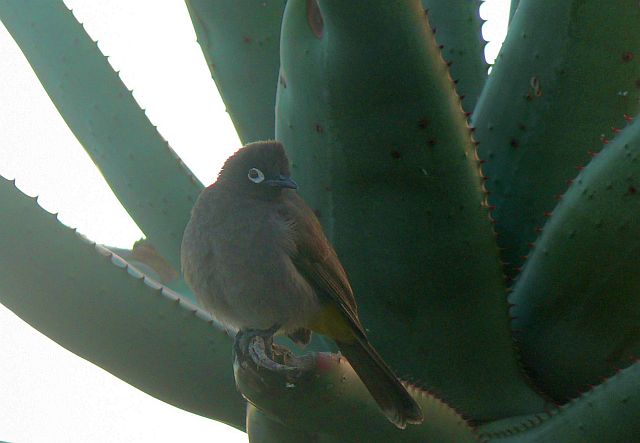
Description
Size 19-21 cm. The plumage is mainly dull, blackish brown. It has distinctive white eye-rings and yellow undertail coverts. The head has a small crest. The short, straight bill, legs and feet are black and the iris is dark brown. Males and females look alike.
Juvenile lacks the white eye-ring and is darker below than Dark-capped Bulbul and African Red-eyed Bulbul.
Overall much darker in appearance than African Red-eyed and Dark-capped Bulbuls, with the dark brown on the underparts extending onto the lower belly. Unlikely to be mistaken for the Dark-capped Bulbul or Red-eyed Bulbul as the ranges do not overlap.
Distribution
Endemic to South Africa, where it is very common across much of the Western Cape, extending along the coast to the Northern and Eastern Cape. It is confined to the southern and western Cape Province, from south of the Orange River in the north to the vicinity of Grahamstown in the east, and inland for approximately 250 km.
Habitat
It generally prefers thickly vegetated fynbos and succulent karoo, as well as coastal scrub, Acacia karoo (Sweet thorn) woodland, suburban parks and gardens.
Diet
It mainly eats fruit, supplemented with arthropods, seeds and nectar. It usually forages in pairs or small groups, plucking fruit from the foliage of trees and bushes, while occasionally hawking invertebrate prey.
Breeding
The Cape Bulbul is a monogamous bird which, usually, pairs for life. It is territorial during the breeding season, though its territory is neither strongly advertised nor defended. The nest is built solely by the female in about 2-10 days, while the male watches intently. It consists of a sturdy but messy cup built of twigs, grass stems and rootlets, built on a foundation of larger twigs and lined with finer planter material. It is typically placed on a horizontal branch near the edge of a bush's or tree's foliage. Egg-laying season is from August-March, peaking, peaking from September-November. It lays 2-5 pink eggs (usually 2-3), which are incubated solely by the female for about 11-13.5 days. It leaves the nest about 20-40 times a day to go foraging, in fact it only spends about 60% of the day incubating. For the first few days the chicks are mainly fed arthropods, but thereafter fruit dominates their diet. Both parents feed the chicks, who leave the nest before they can fly, at about 10-13 days old. They fledge a few days after leaving the nest, but remain dependent on their parents for food for at least two weeks more after leaving. They eventually become fully independent at about 50 days old, at which point they start to sing and call.
Call
The most typical call of this species is a liquid whistle of two or more varied notes pit-peet-pitmajol, piet-piet-patata. Most common call note piet-my-jol. Contact calls sound-like chirrup or key-link; alarm call a low pitched churr. Listen to Bird Call.
Status
Common endemic resident.
Order: Passeriformes. Family: Pycnonotidae

Description
Size 19-21 cm. The plumage is mainly dull, blackish brown. It has distinctive white eye-rings and yellow undertail coverts. The head has a small crest. The short, straight bill, legs and feet are black and the iris is dark brown. Males and females look alike.
Juvenile lacks the white eye-ring and is darker below than Dark-capped Bulbul and African Red-eyed Bulbul.
Overall much darker in appearance than African Red-eyed and Dark-capped Bulbuls, with the dark brown on the underparts extending onto the lower belly. Unlikely to be mistaken for the Dark-capped Bulbul or Red-eyed Bulbul as the ranges do not overlap.
Distribution
Endemic to South Africa, where it is very common across much of the Western Cape, extending along the coast to the Northern and Eastern Cape. It is confined to the southern and western Cape Province, from south of the Orange River in the north to the vicinity of Grahamstown in the east, and inland for approximately 250 km.
Habitat
It generally prefers thickly vegetated fynbos and succulent karoo, as well as coastal scrub, Acacia karoo (Sweet thorn) woodland, suburban parks and gardens.
Diet
It mainly eats fruit, supplemented with arthropods, seeds and nectar. It usually forages in pairs or small groups, plucking fruit from the foliage of trees and bushes, while occasionally hawking invertebrate prey.
Breeding
The Cape Bulbul is a monogamous bird which, usually, pairs for life. It is territorial during the breeding season, though its territory is neither strongly advertised nor defended. The nest is built solely by the female in about 2-10 days, while the male watches intently. It consists of a sturdy but messy cup built of twigs, grass stems and rootlets, built on a foundation of larger twigs and lined with finer planter material. It is typically placed on a horizontal branch near the edge of a bush's or tree's foliage. Egg-laying season is from August-March, peaking, peaking from September-November. It lays 2-5 pink eggs (usually 2-3), which are incubated solely by the female for about 11-13.5 days. It leaves the nest about 20-40 times a day to go foraging, in fact it only spends about 60% of the day incubating. For the first few days the chicks are mainly fed arthropods, but thereafter fruit dominates their diet. Both parents feed the chicks, who leave the nest before they can fly, at about 10-13 days old. They fledge a few days after leaving the nest, but remain dependent on their parents for food for at least two weeks more after leaving. They eventually become fully independent at about 50 days old, at which point they start to sing and call.
Call
The most typical call of this species is a liquid whistle of two or more varied notes pit-peet-pitmajol, piet-piet-patata. Most common call note piet-my-jol. Contact calls sound-like chirrup or key-link; alarm call a low pitched churr. Listen to Bird Call.
Status
Common endemic resident.
Cape Bulbul Photos
566. Cape Bulbul Pycnonotus capensis (Kaapse Tiptol)
 © nan
© nan
West Coast National Park
Links:
Species text Sabap1
Sabap2
Newman's birds of Southern Africa
 © nan
© nan West Coast National Park
Links:
Species text Sabap1
Sabap2
Newman's birds of Southern Africa
- Flutterby
- Posts: 44029
- Joined: Sat May 19, 2012 12:28 pm
- Country: South Africa
- Location: Gauteng, South Africa
- Contact:
Dark-capped Bulbul
568. Dark-capped Bulbul (formerly known as Black-eyed Bulbul) Pycnonotus tricolor (Swartoogtiptol)
Order: Passeriformes. Family: Pycnonotidae
Description
Size 18 cm. The sexes and juveniles are alike.
Adult: Top of head, face and chin dark brown, fading to paler brown on throat and ear coverts. Feathers on back of head slightly elongated to form erectile crest. Remainder of upper parts and wing coverts drab greyish brown. Vent and undertail coverts bright yellow. Bill black. Eyes dark brown; narrow (0.9-1.0 mm) eye ring black.
Similar species: The species lacks the red eye-ring of the Red-eyed Bulbul and has less contrast between the dark head and the breast.
Distribution
It occurs across much of sub-Saharan Africa, from Chad to Ethiopia south to southern Africa. Here it is common to abundant across Zimbabwe, Mozambique, northern Botswana, the Caprivi Strip, abundant resident over a wide range of habitats in the eastern parts of South Africa (the Limpopo Province, Mpumalanga, KwaZulu-Natal and the Eastern Cape).
P. t. layardi: se Kenya to e, s Zambia, ne Botswana and South Africa
P. t. tricolor: e Cameroon to DR Congo, s Sudan, w, c Kenya, Angola, nw Botswana and n, w Zambia
Habitat
It can occupy any habitat with adequate supply of fruiting trees and bushes, absent only from dense woodland or grassland with few bushes. It is particularly common in gardens, plantations and parks in and around human settlements.
Diet
It eats a range of fruit, petals, nectar, seeds and arthropods, foraging in groups and using a wide variety of techniques. These include plucking fruit from trees and bushes, probing the flowers of Aloe for nectar, hawking flying insects, hunting for spiders on buildings and picking up fallen fruit.
Breeding
Monogamous and territorial, with males defending their territories against other males by lowering their wings and head and chasing the intruder. If the confrontation escalates into a fight, the males viciously peck and scratch each other, sometimes interlocking their claws in mid flight and falling to the ground. The female builds the nest, which is a tidy and well-built cup built of rootlets, dry grass and twigs with an outer layer of spider web, and lined with finer plant material. It is typically placed on a branch or slung between a few twigs, generally concealed towards the edge of the canopy, often found in suburban gardens. Egg-laying season is from July-April, peaking around September-December. It lays 2-3 brown-speckled eggs, which are incubated by the female for about 12-15 days, while the male regularly brings her food at the nest. The chicks are brooded almost constantly by the female at first, but thereafter both adults leave the nest repeatedly in search of food. The young stay in the nest for about 11-16 days, leaving before they can fly.
Their nests are sometimes parasitized by the Jacobin cuckoo.
Call
A harsh, sharp kwit, kwit, kwit, given when alarmed or when going to roost; song is a liquid cheloop chreep choop Listen to Bird Call.
Status
One of the most common birds within its range.
Order: Passeriformes. Family: Pycnonotidae
Description
Size 18 cm. The sexes and juveniles are alike.
Adult: Top of head, face and chin dark brown, fading to paler brown on throat and ear coverts. Feathers on back of head slightly elongated to form erectile crest. Remainder of upper parts and wing coverts drab greyish brown. Vent and undertail coverts bright yellow. Bill black. Eyes dark brown; narrow (0.9-1.0 mm) eye ring black.
Similar species: The species lacks the red eye-ring of the Red-eyed Bulbul and has less contrast between the dark head and the breast.
Distribution
It occurs across much of sub-Saharan Africa, from Chad to Ethiopia south to southern Africa. Here it is common to abundant across Zimbabwe, Mozambique, northern Botswana, the Caprivi Strip, abundant resident over a wide range of habitats in the eastern parts of South Africa (the Limpopo Province, Mpumalanga, KwaZulu-Natal and the Eastern Cape).
P. t. layardi: se Kenya to e, s Zambia, ne Botswana and South Africa
P. t. tricolor: e Cameroon to DR Congo, s Sudan, w, c Kenya, Angola, nw Botswana and n, w Zambia
Habitat
It can occupy any habitat with adequate supply of fruiting trees and bushes, absent only from dense woodland or grassland with few bushes. It is particularly common in gardens, plantations and parks in and around human settlements.
Diet
It eats a range of fruit, petals, nectar, seeds and arthropods, foraging in groups and using a wide variety of techniques. These include plucking fruit from trees and bushes, probing the flowers of Aloe for nectar, hawking flying insects, hunting for spiders on buildings and picking up fallen fruit.
Breeding
Monogamous and territorial, with males defending their territories against other males by lowering their wings and head and chasing the intruder. If the confrontation escalates into a fight, the males viciously peck and scratch each other, sometimes interlocking their claws in mid flight and falling to the ground. The female builds the nest, which is a tidy and well-built cup built of rootlets, dry grass and twigs with an outer layer of spider web, and lined with finer plant material. It is typically placed on a branch or slung between a few twigs, generally concealed towards the edge of the canopy, often found in suburban gardens. Egg-laying season is from July-April, peaking around September-December. It lays 2-3 brown-speckled eggs, which are incubated by the female for about 12-15 days, while the male regularly brings her food at the nest. The chicks are brooded almost constantly by the female at first, but thereafter both adults leave the nest repeatedly in search of food. The young stay in the nest for about 11-16 days, leaving before they can fly.
Their nests are sometimes parasitized by the Jacobin cuckoo.
Call
A harsh, sharp kwit, kwit, kwit, given when alarmed or when going to roost; song is a liquid cheloop chreep choop Listen to Bird Call.
Status
One of the most common birds within its range.
- Flutterby
- Posts: 44029
- Joined: Sat May 19, 2012 12:28 pm
- Country: South Africa
- Location: Gauteng, South Africa
- Contact:
Dark-capped Bulbul Photos
568. Dark-capped Bulbul Pycnonotus tricolor

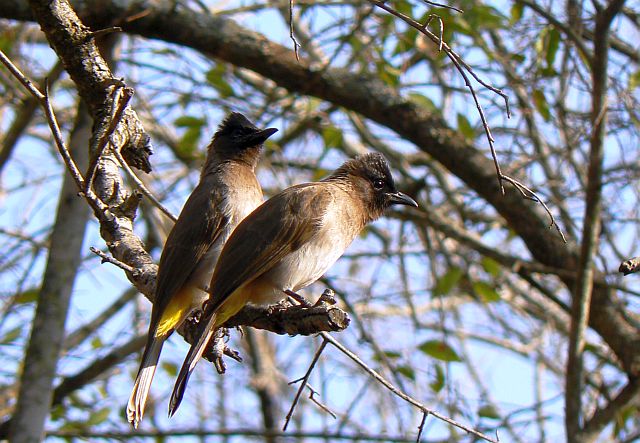 © Toko
© Toko
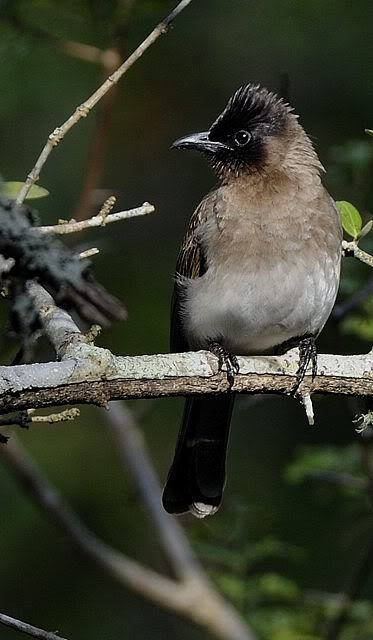 © Dewi
© Dewi
Links:
Sabap2
Species text in The Atlas of Southern African Birds

 © Toko
© Toko © Dewi
© DewiLinks:
Sabap2
Species text in The Atlas of Southern African Birds
Sombre Greenbul
572. Sombre Greenbul Andropadus importunus (Gewone Willie)
Order: Passeriformes. Family: Pycnonotidae
Description
15-18 cm. A drab, olive green bird, paler below, with a white eye. It has a white iris. The sexes are similar in plumage.
Southern form is plain olive-green; northern form, in lower Zambezi valley and beyond, is much yellower, upperparts greener.
Adult: Upper parts, incl wings, dark olive green. Underparts uniform olive-grey, belly slightly paler (a few feathers with pale yellow tips). Bill black to slaty. Eyes white to pale yellow. Legs and feet dark olive-brown, grey or black.
Juveniles are even duller than the adult and have dark eyes.
Distribution
From Kenya through eastern Tanzania and northern Mozambique to southern Africa. Here it is common across Mozambique, eastern Zimbabwe, Limpopo Province, Mpumalanga, Swaziland, KwaZulu-Natal, the Eastern and Western Cape.
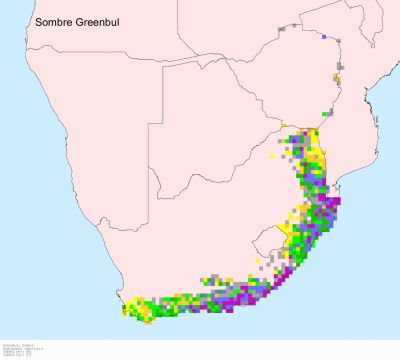
Habitat
Evergreen forests, coastal shrub, thornveld and sandforest.
Diet
It eats mainly eats fruit, foraging in the foliage of trees and bushes, regularly singing its distinctive call.
Breeding
The nest is built solely by the female, consisting of an open, flimsy cup built rootlets, twigs, grass and other plant material. It is usually placed in the fork of or at the end of a tree or bush branch, 1-4 m above ground, typically attached with spider web. Egg-laying season is from September-April, peaking from October-December. The female lays 1-3 eggs, which are incubated solely by the female for about 12-13.5 days, the male regularly bringing her food. At first it is quite skittish when disturbed at the nest, but later in the incubation period it sits tight, not even deserting when touched. The chicks are fed and brooded by both adults, leaving the nest after approximately 10-14 days, becoming independent a few weeks later.
Call
Contact call ringing wi-llie. Song rapid jumble of loud notes ending in nasal slurr, willie, come-and-have-a-fight, sca-a-a-ared. Listen to Bird Call.
Status
Common resident.
Order: Passeriformes. Family: Pycnonotidae
Description
15-18 cm. A drab, olive green bird, paler below, with a white eye. It has a white iris. The sexes are similar in plumage.
Southern form is plain olive-green; northern form, in lower Zambezi valley and beyond, is much yellower, upperparts greener.
Adult: Upper parts, incl wings, dark olive green. Underparts uniform olive-grey, belly slightly paler (a few feathers with pale yellow tips). Bill black to slaty. Eyes white to pale yellow. Legs and feet dark olive-brown, grey or black.
Juveniles are even duller than the adult and have dark eyes.
Distribution
From Kenya through eastern Tanzania and northern Mozambique to southern Africa. Here it is common across Mozambique, eastern Zimbabwe, Limpopo Province, Mpumalanga, Swaziland, KwaZulu-Natal, the Eastern and Western Cape.

Habitat
Evergreen forests, coastal shrub, thornveld and sandforest.
Diet
It eats mainly eats fruit, foraging in the foliage of trees and bushes, regularly singing its distinctive call.
Breeding
The nest is built solely by the female, consisting of an open, flimsy cup built rootlets, twigs, grass and other plant material. It is usually placed in the fork of or at the end of a tree or bush branch, 1-4 m above ground, typically attached with spider web. Egg-laying season is from September-April, peaking from October-December. The female lays 1-3 eggs, which are incubated solely by the female for about 12-13.5 days, the male regularly bringing her food. At first it is quite skittish when disturbed at the nest, but later in the incubation period it sits tight, not even deserting when touched. The chicks are fed and brooded by both adults, leaving the nest after approximately 10-14 days, becoming independent a few weeks later.
Call
Contact call ringing wi-llie. Song rapid jumble of loud notes ending in nasal slurr, willie, come-and-have-a-fight, sca-a-a-ared. Listen to Bird Call.
Status
Common resident.
Dewi
What is the good of having a nice house without a decent planet to put it on? (H D Thoreau)
What is the good of having a nice house without a decent planet to put it on? (H D Thoreau)
Sombre Greenbul Photos
572. Sombre Greenbul Andropadus importunus
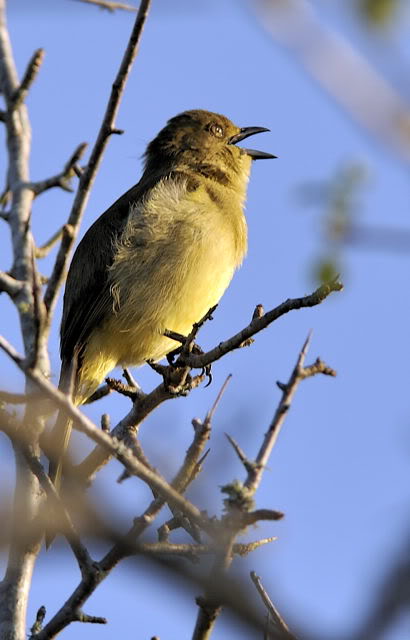 © Dewi
© Dewi
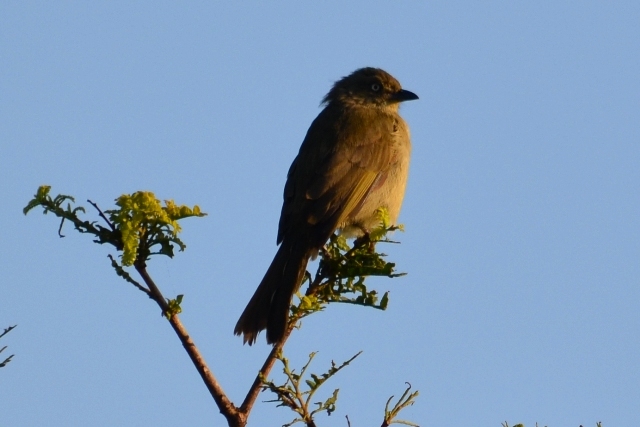 © Mel
© Mel
 © Flutterby
© Flutterby
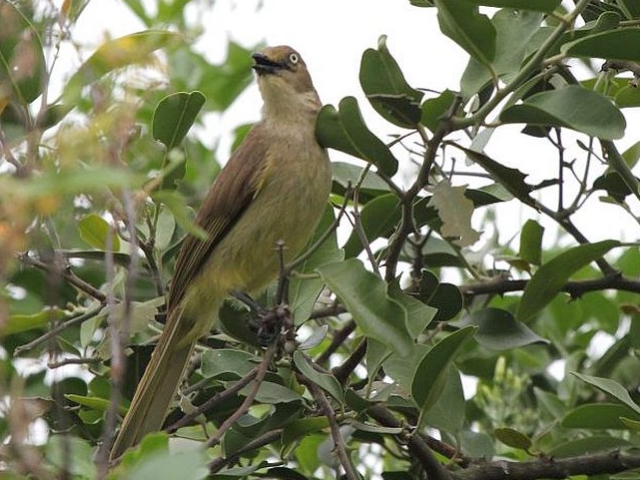 © Duke
© Duke
Kruger National Park
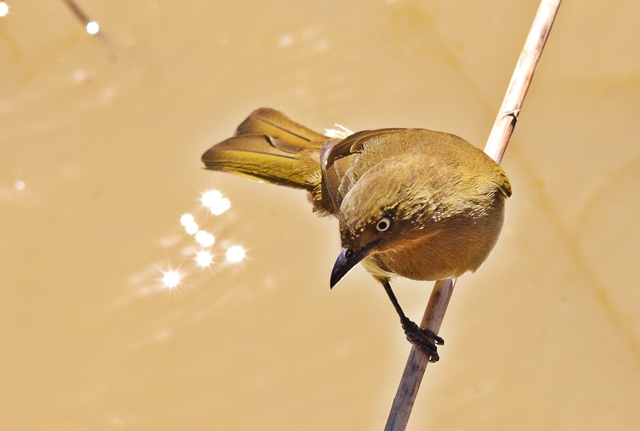 © Flutterby
© Flutterby
uMkhuze Game Reserve, kuMasinga Hide (KZN)
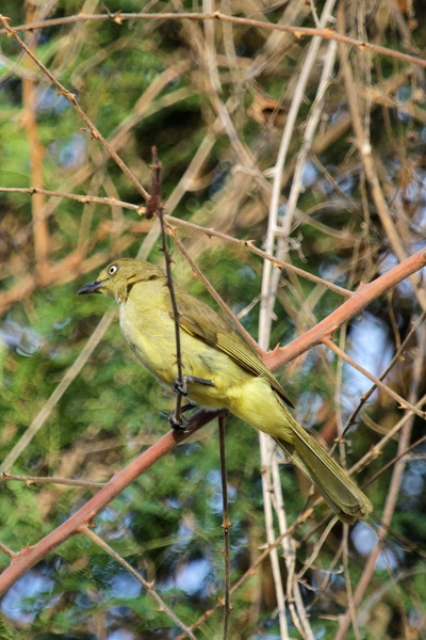 © leachy
© leachy
Kruger National Park, Pafuri
Links:
Species text Sabap1
http://sabap2.adu.org.za/species_info.p ... #menu_left
Newman's Birds of Southern Africa
 © Dewi
© Dewi © Mel
© Mel © Flutterby
© Flutterby © Duke
© DukeKruger National Park
 © Flutterby
© FlutterbyuMkhuze Game Reserve, kuMasinga Hide (KZN)
 © leachy
© leachyKruger National Park, Pafuri
Links:
Species text Sabap1
http://sabap2.adu.org.za/species_info.p ... #menu_left
Newman's Birds of Southern Africa
Dewi
What is the good of having a nice house without a decent planet to put it on? (H D Thoreau)
What is the good of having a nice house without a decent planet to put it on? (H D Thoreau)


